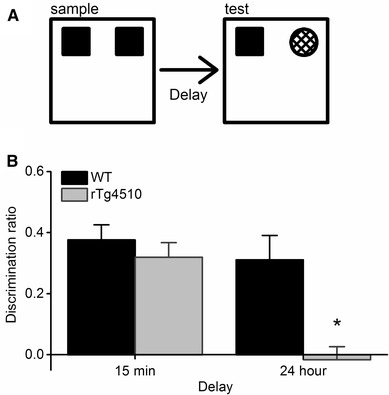Fig. 1.

Novel object recognition memory is impaired in rTg4510 mice. a Schematic representation of the novel object recognition task. During the sample phase, the mice are placed in a square arena and presented with two identical objects and allowed to freely explore for 10 min. The mice were then removed from the arena and, following a variable delay period of either 15 min or 24 h, were returned to the arena for the test phase, where they were presented with one object identical to the two presented in the sample phase and a novel object. The discrimination ratio was calculated as the time spent exploring the novel object divided by the total exploration time. b When a 15 min delay period was imposed, both WT and rTg4510 mice (n = 15 for both groups) were capable of discriminating between the novel and familiar objects, and thus spent significantly more time exploring the novel objects (P < 0.05, one sample t-test). However, when a 24 h delay period was imposed, only the WT mice were able to discriminate between the novel and familiar object (P < 0.05, one sample t test), whilst rTg4510 mice could not (P = 0.7, one-sample t test). ANOVA revealed a significant main effect of genotype (F1,28 = 10.7, P = 0.003) and a significant delay x genotype interaction (F1,28 = 6.13, P = 0.02,*)
